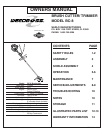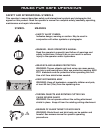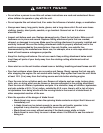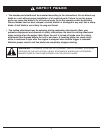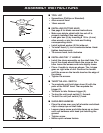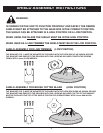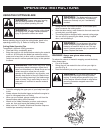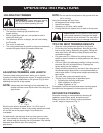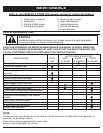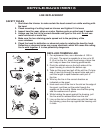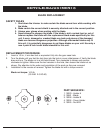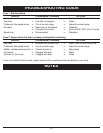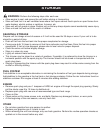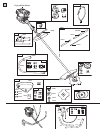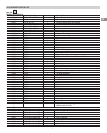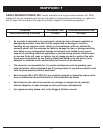
1
SAFETY RULES
• Do not allow a person to use this unit unless instructions are read and understood. Never
allow children to operate or play with the unit.
• Do not operate this unit when tired, ill or under the influence of alcohol, drugs, or medication.
• Always wear heavy, long pants, boots, gloves, and a long sleeve shirt. Do not wear loose
clothing, jewelry, short pants, sandals, or go barefoot. Secure hair so it is above
shoulder level.
• Inspect unit before each use. Replace damaged parts. Check for fuel leaks. Make sure all
fasteners are in place and secure. Replace cutting attachment parts that are cracked,
chipped, or damaged in any way. Make sure the cutting attachment is properly installed and
securely fastened. Be sure the cutting attachment shield is properly attached, and in the
position recommended by the manufacturer. Use only flexible, non-metallic line
recommended by the manufacturer. Never use, for example, wire or wire-rope which can
break off and become a dangerous projectile.
• Keep firm footing and balance. Do not over-reach. Keep cutting attachment below waist
level. Keep all parts of your body away from the rotating cutting attachment and hot
surfaces.
• Never start or run the unit inside a closed room or building; breathing exhaust fumes can kill.
• Pour fuel outdoors where there are no sparks and flames. Slowly remove the fuel cap only
after stopping the engine. Do not smoke while fueling. Wipe spilled fuel from the unit. Move
at least 10 ft. (3 m) away from the fueling source and site before starting engine.
• Clear the area to be cut before each use. Remove all objects such as rocks, broken glass,
nails, wire, or string which can be thrown or become entangled in the cutting attachment.
Clear the area of children, bystanders and pets. At a minimum, keep all children, bystanders
and pets outside a 50 ft. (15 m) radius; outside the 50 ft. zone, there is still a risk of injury
to bystanders from being struck with the moving blade in the event of a blade thrust or
other unexpected reaction of the saw.
• Warn the operator of the danger of blade thrust.
• Blade thrust may occur when the spinning blade contacts an object that it does not
immediately cut.
• A blade thrust can be violent enough to cause the unit and/or operator to be
propelled in any direction, and possibly lose control of the unit.
• Blade thrust can occur without warning if the blade snags, stalls or binds.
• Blade thrust is more likely to occur in areas where it is difficult to see the material
being cut.



